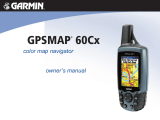
Start-Up and Satellite Acquisition
Find a location where you have a clear view of the sky. If you’re
starting up for the first time or you have moved over 600 miles since
last using the GPSMAP 60Cx, it must initialize (determine its loca-
tion by searching for satellites that are in position over your current
location.) Press the
MENU key to use the Location option from the
Satellite Page Options Menu to mark your approximate location on
the Map Page so it looks for only those satellites above your location.
1. Turn On the GPSMAP 60Cx by pressing and releasing the
POWER key. A Welcome Page will briefly appear before
moving to the Satellite Page.
2. Observe the Satellite Page and the GPS status messages
as they appear at the top of the page.
• “Acquiring Satellites” message appears as the GPSmap
60C begins to search for satellites overhead.
• Your “Location Coordinates” display when four or
more satellites are fixed (enough to determine an ap-
proximate elevation as well as ground location).
Unit Operation
Key Function
Battery Installation
The GPSMAP 60Cx operates on two “AA” batteries (not includ-
ed), which are located in the back of the unit. Alkaline or NiMH
batteries may be used (see the Owner’s Manual to set the battery
type). Stored data is not lost when the batteries are removed.
Battery Compartment
USE BY: 2009
USE BY: 2009
Locking
Pin Slot
1. To remove the battery cover
from the back of the unit,
turn the D-Ring 1/4 turn
counter-clockwise and then
pull the cover away.
2. Insert the batteries, observ-
ing the proper polarity.
A polarity diagram can be
found molded into the battery
compartment.
3. Reinstall the battery cover by
inserting the bottom slot over
the tab at the base of the
unit and reinserting the
locking pin in the back of the
unit.
4. Turn the D-Ring 1/4 turn
clockwise to lock the cover in
place.
When replacing batteries, use only new
or fully charged batteries. Do not mix
Alkaline and NiMH batteries. Recharge-
able batteries may have less capacity than
disposable batteries.
Extensive use of backlighting and/or WAAS
as well as key beep tones will significantly
reduce battery life.
Battery Cover
Backlight
Adjustment
Slider
IN
OUT
FIND
PAGE
MARK
ENTR
QUIT
V
V
V
V
MENU
POWER/BACKLIGHT Key - Press and hold to turn
unit On/Off. Press and release to adjust backlighting.
IN/OUT Zoom Keys - From the Map Page, press to
zoom in or out. From any other page, press to
scroll up or down a list.
FIND/MOB Key - Press and release at any time to
view the Find Menu Page. Press and hold for
MOB feature.
MARK Key - Press and release at any time to mark
your current location as a waypoint.
QUIT Key - Press and release to cancel data entry or
exit a page.
PAGE Key - Press to cycle through the main pages.
Press when using the on-screen keyboard to close.
MENU Key - Press and release to view options
for a page. Press twice to view the Main Menu.
ENTER Key - Press and release to enter highlighted
options, data or confirm on-screen messages.
ROCKER Key -
Move Up/Down or Right/Left to
move through lists, highlight fields, on-screen
buttons, icons, enter data or move the map pan-
ning arrow.
If the GPSMAP 60Cx can’t get past the “Acquiring Satellites”
message or you get a “Lost Satellite Signal” message, move to a new
location away from tall overhead obstacles.
Satellite Page
Displays your location coordinates, position accuracy, a view of the satellites
overhead, and bar graph showing the signal strength of each overhead satellite.
Satellite Page
Options
•
Turn GPS Off
• Orient display
to your direction
of movement “Track
Up” or... “North
Up” (as shown).
•
Change display colors
•
Use Map Page to
mark your location.
•
GPS Elevation
Status Bar
3D GPS
indicator
Received
Satellite icon
Position Bug indi
-
cates your direction
of movement
Overhead
Satellite not
yet received
Adjusting the Backlighting
Lighting conditions may make it difficult to view the GPSMAP
60Cx display. If so, you may need to turn on the backlighting and
adjust it to the desired level of brightness. Use of backlighting
increases the rate of battery depletion.
Viewing the Main Pages
The Main Pages provide the information you need for basic
navigation using the GPSMAP 60Cx. Press the PAGE key repeat-
edly to cycle from one Main Page to another.
1. With the GPSMAP 60Cx On, press and
release the POWER key to display the
Backlight Adjustment Slider.
2. Press and release the POWER key to
i
ncrease the brightness level to maximum.
3. Allow the Adjustment Slider to close on
its own or press the
ENTER key.
The backlight is factory set to timeout in 15
seconds, unless connected to an external power
source. Refer to Display Setup in the Owner’s
Manual to change the timeout period for the
backlight.
Satellite Page - Provides reference for satellites being tracked,
Trip Computer Page - Provides trip and navigation data.
Map Page - Displays a map and references your movements.
Compass Page - Provides guidance to a destination.
Main Menu - A directory of advanced features and settings.
Satellite
Page
Trip Computer
Page
Map
Page
Compass
Page
Main
Menu
D-Ring
Satellite Signal
Status Bars
The Micro SD Card used for storing detailed
mapping data is located beneath the
batteries. Refer to the Owner’s Manual for
detailed information.


